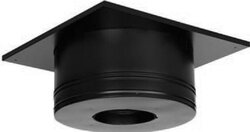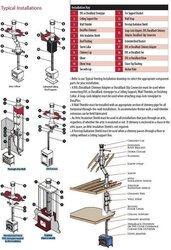Hello all! I've been reading around the site a bit and I've come to the point that I need to ask a question. First a bit of background.
I've come to discover that what I thought was going to be a simple wood burning insert installation is now going to be a massive tear down and replace job. What I have in my house is a zero clearance majestic stove from the late 70s that as been incorrectly converted to gas and is missing its double wall chimney pipe and interior fire plates. Its been cobbled on over the past several owners to the point that its no longer safe to use. I've read up a fair bit, and I don't think my fireplace inspector/salesman is trying to sell me a bill of goods. Everything he showed me adds up. Also on the topic, is anyone familiar with Stars Chimney Service in Fort Wayne Indiana? I'd love to hear some feedback. Anyhow, moving on to the question.
Stars is recommending a complete tear down of the existing masonry zero clearance unit and replacement with a Napoleon 1900. Overall, that doesn't offend me since the 1900 will have about twice the BTU output as the inserts I was looking at and can realistically heat my leaky 1000ft^3 house (1000 up, 1000 down in finished basement, which is where the stove will be). As far as my research as taken me, the Napoleon is a good robust unit with tons of favorable feedback all over the internet world. But, here in lies my problem. As I said, I have a completely finished and detailed zero clearance "fireplace" that looks very nice, but is a fire hazard. By breaking it all out and taking it out the backdoor with a wheel barrel, I'll be left with a very ugly unfinished bare concrete floor and bare concrete basement wall behind the unit. The tab for the stove and installation is just shy of $5k, so I really can't afford to do anything in terms of hiring a stone mason to come in and do some really great hearth and back wall right at the moment.
I have not yet asked the installer these questions because I would like to know something about the answers beforehand.
The questions:
*Is there anything in the pre-manufactured world that a skilled home owner can simply install? Can I order a heart as some reasonable cost and just put it on the floor under the stove to cover the concrete?
*What is generally considered safe when it comes to hearths? What is not? I assume bare concrete will be safe, but certainly ugly.
*If I can't afford to do *anything* about a good looking hearth right now, is it acceptable or wise to place the stove on a couple of risers (bricks, maybe 2" tall) so that later on the chimney won't have to be re-fit when an ornamental hearth is installed, due to the height change?
*Should I pull a building permit (regardless of whether or not it is illegal to do this type of work without one) for my own protection?
I'm interested in opinions on the cost and equipment as well. I've been quoted 1999.99 ("on sale") for the stove with unspecified options. I assume doors are included, but I doubt a blower is. $1100 for the pipe from the basement to the roof and $300 for parts such as a flue, chimney temp gauge, and rain cap. Labor to install it is right around $1000. I'm sure that there are many people here that have installed their own equipment, but that's out of the question for me in this case. Professional installation and sale from a certified chimney sweep is mandatory for me for insurance and legal reasons. I'm ok with paying a slight premium to buy local and have continued support after the sale, but I don't want to be a sucker either. Stars has already said that they would be happy to install equipment purchased elsewhere if I wish, which to me is a big plus. Many contractors won't touch product that isn't their own. In my opinion, a true craftsman can take any lumber and build a house if they have the right skills.
I've come to discover that what I thought was going to be a simple wood burning insert installation is now going to be a massive tear down and replace job. What I have in my house is a zero clearance majestic stove from the late 70s that as been incorrectly converted to gas and is missing its double wall chimney pipe and interior fire plates. Its been cobbled on over the past several owners to the point that its no longer safe to use. I've read up a fair bit, and I don't think my fireplace inspector/salesman is trying to sell me a bill of goods. Everything he showed me adds up. Also on the topic, is anyone familiar with Stars Chimney Service in Fort Wayne Indiana? I'd love to hear some feedback. Anyhow, moving on to the question.
Stars is recommending a complete tear down of the existing masonry zero clearance unit and replacement with a Napoleon 1900. Overall, that doesn't offend me since the 1900 will have about twice the BTU output as the inserts I was looking at and can realistically heat my leaky 1000ft^3 house (1000 up, 1000 down in finished basement, which is where the stove will be). As far as my research as taken me, the Napoleon is a good robust unit with tons of favorable feedback all over the internet world. But, here in lies my problem. As I said, I have a completely finished and detailed zero clearance "fireplace" that looks very nice, but is a fire hazard. By breaking it all out and taking it out the backdoor with a wheel barrel, I'll be left with a very ugly unfinished bare concrete floor and bare concrete basement wall behind the unit. The tab for the stove and installation is just shy of $5k, so I really can't afford to do anything in terms of hiring a stone mason to come in and do some really great hearth and back wall right at the moment.
I have not yet asked the installer these questions because I would like to know something about the answers beforehand.
The questions:
*Is there anything in the pre-manufactured world that a skilled home owner can simply install? Can I order a heart as some reasonable cost and just put it on the floor under the stove to cover the concrete?
*What is generally considered safe when it comes to hearths? What is not? I assume bare concrete will be safe, but certainly ugly.
*If I can't afford to do *anything* about a good looking hearth right now, is it acceptable or wise to place the stove on a couple of risers (bricks, maybe 2" tall) so that later on the chimney won't have to be re-fit when an ornamental hearth is installed, due to the height change?
*Should I pull a building permit (regardless of whether or not it is illegal to do this type of work without one) for my own protection?
I'm interested in opinions on the cost and equipment as well. I've been quoted 1999.99 ("on sale") for the stove with unspecified options. I assume doors are included, but I doubt a blower is. $1100 for the pipe from the basement to the roof and $300 for parts such as a flue, chimney temp gauge, and rain cap. Labor to install it is right around $1000. I'm sure that there are many people here that have installed their own equipment, but that's out of the question for me in this case. Professional installation and sale from a certified chimney sweep is mandatory for me for insurance and legal reasons. I'm ok with paying a slight premium to buy local and have continued support after the sale, but I don't want to be a sucker either. Stars has already said that they would be happy to install equipment purchased elsewhere if I wish, which to me is a big plus. Many contractors won't touch product that isn't their own. In my opinion, a true craftsman can take any lumber and build a house if they have the right skills.




